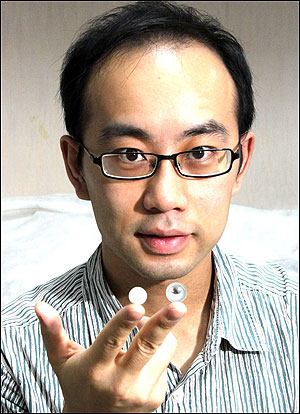After a decade spent researching and developing technology for authenticating cultured pearls, Fukui Shell Nucleus Factory, a Hong Kong provider of equipment and services to the pearl industry, has released a solution consisting of a tiny radio frequency identification tag embedded in a pearl’s nucleus that could transmit an ID number to an RFID reader. The tag would make it possible for pearl farmers, wholesalers, retailers and customers to identify and track a pearl 9 millimeters (0.4 inch) or more in diameter, from its origins as a nucleus until a customer’s purchase of the harvested pearl. The tagged nuclei are commercially available now, but David Wong, the company’s project director, says the advent of a pearl-tracking database would be what makes the technology most significant for the entire industry. The firm is currently in the process of developing that database, which it will host.
All cultured pearls are created using a nucleus—material from another shell that is inserted into an oyster or mussel. The mollusk secretes material known as nacre to cover that nucleus, eventually creating a pearl. Fukui Shell, which makes these nuclei for pearl farmers, saw an opportunity, as much as a decade ago, to help industry members prove the authenticity, origins and history of every pearl—each of which can be very high in value.

“Pearl buyers only know about getting big and beautiful pearls without learning about the background of each pearl,” Wong says. In addition, salespeople are often misinformed about a pearl’s origin, leaving customers in the position of hoping the information they have about the gems they buy is accurate. According to Wong, customers who are assured of a full record of a pearl’s origins and history are more likely to make a purchase.
Fukui Shell looked into several options, most of which it quickly ruled out. Drilling a hole in a pearl to embed an RFID tag would be destructive, Wong says, while laser-printing an ID number on its surface also could result in damage. Therefore, the company sought to create a unique ID that could be accessed from the nucleus through the pearl.
During the past few years, Fukui Shell Nucleus Factory began working with a pearl farm to test a new type of nucleus that could be made larger by applying lamination over the nucleus itself. The lamination completely seals off the inside of the nucleus from the outside (the host mollusk’s secretions), thereby making it possible to ensure that an RFID tag could remain protected after the nucleus’ insertion into an oyster. After conducting research, the company discovered a passive ultrahigh-frequency (UHF) EPC Gen 2 RFID tag small enough to be embedded in the nucleus. It then began placing tagged nuclei inside oysters, and started working with RFID readers to interrogate those tags. Wong declines to reveal the tag’s specific model or size, but reports that it is small enough to fit into a nucleus measuring 12 millimeters (0.5 inch) or less in diameter. Wong recommends the solution for pearls that will measure at least 9 millimeters (0.4 inch), such as South Sea pearls and Tahitian black pearls, but notes that an RFID-enabled nucleus “could be much smaller than that.”
Fukui Shell mimicked the conditions under which RFID-tagged nuclei would be inserted into the oysters. For example, the firm tested whether alcohol would leak into the tag through the laminate, and also conducted drop, pressure and heating tests. The alcohol selected for the test was brandy, Wong says, so that if any fluid leaked through the laminate, he would be able to detect it due to resulting color changes to the nuclei. The company then tried using a handheld reader to capture the tag’s unique ID number. The technology worked well, Wong says.
The RFID tag cannot be read when a nucleus is embedded in a shellfish. However, Wong says, Fukui Shell is presently carrying out further research and development, in order to make such a read event possible. Currently, he adds, pearl cultivators employ X-ray technology to detect whether a nucleus is still in the shell during the cultivation process (or has been expelled by the shellfish), but the use of X-rays can be expensive and hazardous to a mollusk’s health.
In June of this year Wong presented the testing results to the public. In the meantime, he says, the system is still being piloted at the same unnamed pearl farm.
The company is now in the early stages of developing a database that would contain information about the tagged pearls and share it with participating supply chain members. For example, a nucleus could be tagged and its unique ID number linked to data regarding that nucleus, such as when and where it was created. The pearl farmer could also input data about the pearl made from that nucleus, including dates and the specific oyster used, as well as the location. Once the pearl was harvested, descriptive information could be input into its digital history, which could later be accessible to retailers or customers.
In this way, Wong says, individuals could ensure that a particular pearl was authentic, as well as learn its history.
“Ultimately, we want the pearl to be able to tell its own story,” Wong states. After all, he says, every pearl has its own unique identity and has undergone a period of cultivation lasting a year or more. In order to accommodate all parameters used to describe a pearl, a database must be built.
Pearl farms and other businesses can buy the RFID-enabled nuclei now, however, and could initially use their own software and database to provide an individual authenticating identifier. A company’s customers could then read the tags if they used the same software to access that database.

